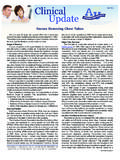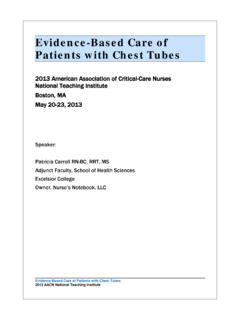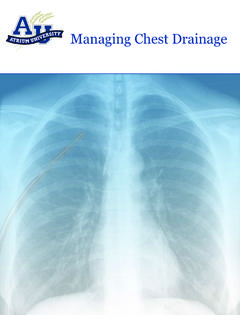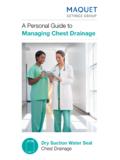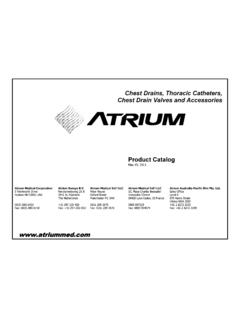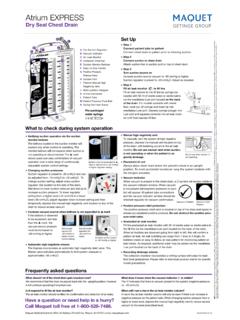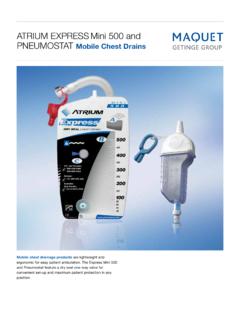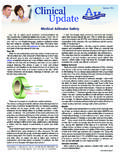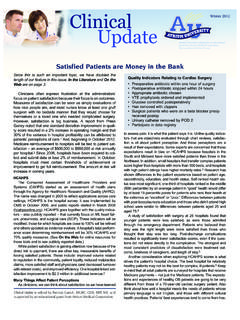Transcription of Dressings for Chest Tubes - Atrium Med
1 Spring 2012. Dressings for Chest Tubes Chest tube dressing care is the one aspect of care for paper tape or As few as four tape strippings can patients with Chest drainage that is repeatedly questioned, yet cause cellular damage to the epidermis, and irritation can also completely lacking in research for guidance. Anecdotally, pub- alter the skin's protective properties even if the skin appears lished reports recommend fenestrated gauze wrapped around intact. A study on CABG patients compared paper tape the tube and covered with adhesive tape1 or using Bioclusive (a (Micropore) with polyethylene tape (Transpore); the tapes' adhe- transparent film dressing) after tube removal to cover the suture sives were the Initially, a dry gauze dressing was and allow for anchored with cloth tape in the OR; at the first dressing change, Petroleum Gauze patients were randomly assigned to one of the two study However, a few weeks ago, the first article on potential neg- tapes for dressing changes on POD 2 & 3.
2 The paper tape result- ative effects of petroleum gauze was published online. Many ed in significantly less irritation and significantly less stripping. surgeons insist on using petroleum gauze at Chest tube sites Researchers attributed the differences to the paper tape's gas even though no evidence supports this ,3 Now, we permeability that also allowed moisture to evaporate. In another have a small study in which researchers explored the effect of study, skin covered with occlusive tape that prevented water loss petroleum gauze on suture Researchers exposed increased bacterial growth from 1000/cm2 to suture knots tied with four different materials polydioxanone Recommendations for Practice (PDS-II), silk, glycolide/lactide copolymer (Polysorb), and polyg- General surgical site care guidelines recommend protecting lyconate to either petroleum gauze or to normal saline-soaked the incision with a sterile dressing for 24 to 48 hours and using gauze.
3 Some knots failed by untying rather than breakage; 5 of an aseptic no-touch technique or full sterile technique for remov- 6 that untied were exposed to petroleum. Knots exposed to ing or changing Dressings after performing proper hand hygiene. petroleum broke at significantly lower tensile strength than those Use sterile saline for wound cleansing for the first 48 hours exposed to saline, with silk and polydioxanone failing at statisti- postop, avoid topical antimicrobial agents when wounds are cally significantly lower tensile loads. This is an in vitro study so healing by primary intention, and aggressively manage postop- it may or may not translate directly to Chest tube Dressings .
4 But, erative glucose it's a start. While it's important to consider cost of the dressing, a single Postoperative Dressings infection (minimum $8118, up to five times the baseline cost of Since there is no research on Chest tube Dressings specifical- surgery) can easily wipe out any savings between dressing ly, the next option is considering the literature relating to ster- ,7 Not only do frequent dressing changes cost more in notomy incisions for some guidance. Various dressing materials nursing time and in supplies used as well as causing skin strip- have been evaluated: dry absorbent pad, hydrocolloid, hydroac- ping with tape removal, but each dressing change also increas- tive, Bioclusive, and medicated pad or The ideal dressing es the risk for wound contamination and subsequent should maintain a moist environment, be gas permeable, protect Taking all of this into consideration, the literature supports these from contamination, allow ongoing assessment, be comfortable, recommendations.
5 Cost effective, and removed without causing tissue ,9 Do not routinely change Dressings unless the dressing is Postoperative Dressings should stimulate superficial epithelial- compromised in some way or there is a significant need to ization at the wound ,8,9 The table on page 3 summa- visualize the tube insertion site based on changes in the rizes the study findings. patient's condition. Hydrocolloid Dressings allow for the best seal around the Use a dry, sterile dressing and secure the dressing with wide wound and are waterproof for bathing. They are not transparent, paper tape. so clinicians need to be comfortable with other assessments, Once the tube is removed, a transparent film dressing would because frequent dressing changes defeat the purpose of the be preferable if the patient plans to shower.
6 Hydrocolloid While the current body of research does not specifically Another factor to consider is skin damage related to adhesive examine Chest tube Dressings , we can begin to develop an evi- removal with repeated dressing changes9 because impaired dence-based approach with these studies on postoperative skin integrity is a significant risk factor for infection. Hydroactive Dressings in the same patient population. film caused more tissue damage compared with traditional Sources on page 2. Check out Ask the Expert now available at Clinical Update is edited by Patricia Carroll, RN,BC, CEN, RRT, MS. and You can submit a question about caring for patients with supported by an educational grant from Atrium Medical Corporation.
7 Chest drainage and read questions from your colleagues with the evidence-based answers. Spring 2012. In the Literature M&Ms Not Just for Docs One hallmark of professional practice is engaging in reflective practice and learning from errors. Nurses naturally think about every little thing that might have contributed to error, but a guided forum among colleagues can examine root causes, identify pat- terns and systems issues and identify topics for further investiga- tion. The current issue of AACN Advanced Critical Care describes such a program at Lucile Packard Children's Hospital in Palo Alto, CA. Once nurses reflect and discuss at the M&M conference, issues are identified.
8 These are then reviewed in the literature, syn- thesized and presented as an educational session for the rest of the staff. These cycles of inquiry and learning are constructive, support patient safety, enhance professional autonomy and responsibility, Join the Nurses' Health Study 3! and foster evidence-based interdisciplinary practice in the cardio- More than 230,000 nurses all over the have been vascular ICU. Team members were able to successfully move from participating in the Nurses' Health Studies 1 & 2 since error finding and blame to an evidence-based systems analysis the program started in the 1970s. Researchers are through continuous quality improvement.
9 Now recruiting the third cohort and looking for women Source: Staveski S, et al.: Nursing mortality and morbidity and journal club who are nurses or nursing students ages 20 to 46. cycles. AACN Advanced Critical Care 2012;23(2):133-141. PubMed Citation years. Nurses are uniquely dedicated to completing the annual surveys and have contributed to the Bringing Evidence to a Practice Island groundbreaking work this research group has done on The current issue of Worldviews on Evidence-Based Nursing women's health. focuses on the role of technology for enhancing evidence-based practice in nursing care. Researchers in Wisconsin report on a pilot Essential Nursing Resources online journal club as a strategy for bringing isolated school nurses This year marks the 26th edition of the Essential together with other school nurse colleagues with whom they did not Nursing Resources, published by the Interagency share a building for on-site workplace collaboration, consultation Council on Information Resources in Nursing.
10 It started and support. Meetings were held virtually at the end of the school as a simple list of resources every nursing library day for one hour; nurses logged in to a meeting site to participate should have and has expanded into a comprehensive in the discussions. reference of resources in a variety of media. Topics The researchers provide a great description of their process and range from alerting services to grants and statistical how it could be used or adapted in other practice settings in which resources. Download your copy at: nurses are physically isolated from professional colleagues. Their project not only encouraged participation, but also had nurses ask- ing for more.
